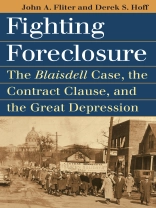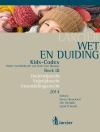In the depths of the Great Depression, when foreclosure rates skyrocketed across the United States, more than two dozen states passed mortgage-extension or -adjustment laws to help farmers and homeowners keep their properties. One such statute in Minnesota led to the most important property law case of its time and still casts a long shadow upon constitutional debates and our own era’s severe economic downturn.
Fighting Foreclosure marks the first book-length study of the landmark 1934 Supreme Court decision in Home Building and Loan Association v. Blaisdell, which, by a 5-4 vote, upheld the Minnesota Mortgage Moratorium Act. On the one hand, Blaisdell validated efforts by states to offer legislative relief to citizens struggling to keep their farms and homes. On the other, it caused an outcry among banking interests and conservative legal theorists, who argued that these laws violated the Contract Clause of the Constitution and interfered with our free market system.
In his majority opinion, Chief Justice Charles Evans Hughes argued that the reasonable and limited nature of the law and the unusual severity of the emergency it addressed placed it firmly within the ‘police powers’ of the states to protect the health and safety of the people. In a strongly worded dissent, Justice George Sutherland argued for a consistent and strict interpretation of the Contract Clause regardless of economic exigency.
John Fliter and Derek Hoff provide a concise history and analysis of not only this landmark case and the reasoning behind its sharply divided decision but also of the entire history of the Contract Clause. They trace closely the agricultural crisis, political pressures, and farmer-protest movement that produced the Minnesota law. And their study contributes to scholarly debate about the origins of the Constitutional Revolution of 1937, by which the Supreme Court accepted the New Deal, as well as to public debates about constitutional interpretation and the role that government should play in providing relief to distressed citizens.
In the midst of our nation’s ongoing suffering from massive foreclosures and bankruptcies, Fighting Foreclosure also offers a potent reminder that the High Court’s decisions often revolve around lives at risk as much as abstract legal debates.
विषयसूची
Editors’ Preface
Acknowledgments
Introduction
1. Origins of the Contract Clause
2. The Supreme Court and the Contract Clause Prior to Blaisdell
3. “And We Didn’t Mean Maybe”: Farmers Demand a Holiday
4. Passing the Minnesota Mortgage Moratorium Act
5. The Minnesota Mortgage Moratorium Act in State Court
6. The Hughes Court: Four Horsemen, Three Muskateers, and Two Swingers
7. The Supreme Court Decides: “A Rational Compromise between Individual Rights and Public Welfare”
8. Reaction to the Blaisdell Decision
Postscript on the Great Recession’s Mortgage Crisis
Chronology
Relevant Cases
Bibliographical Essay
Index
लेखक के बारे में
John A. Fliter and Derek S. Hoff are associate professors at Kansas State University in political science and history, respectively. Fliter is author of Prisoners’ Rights: The Supreme Court and Evolving Standards of Decency; Hoff is author of The State and the Stork: The Population Debate and Policy Making in U.S. History.












